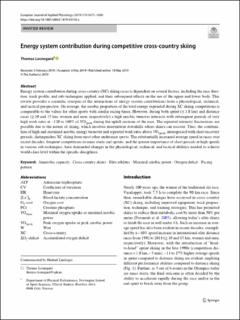| dc.contributor.author | Losnegard, Thomas | |
| dc.date.accessioned | 2020-04-23T10:38:29Z | |
| dc.date.available | 2020-04-23T10:38:29Z | |
| dc.date.created | 2019-06-19T11:30:20Z | |
| dc.date.issued | 2019 | |
| dc.identifier.citation | European Journal of Applied Physiology. 2019, 119(8), 1675-1690. | en_US |
| dc.identifier.issn | 1439-6319 | |
| dc.identifier.uri | https://hdl.handle.net/11250/2652206 | |
| dc.description | This article is distributed under the terms of the Creative Commons Attribution 4.0 International License (http://creativecommons.org/licenses/by/4.0/), which permits unrestricted use, distribution, and reproduction in any medium, provided you give appropriate credit to the original author(s) and the source, provide a link to the Creative Commons license, and indicate if changes were made. | en_US |
| dc.description.abstract | Energy system contribution during cross-country (XC) skiing races is dependent on several factors, including the race dura-tion, track profile, and sub-techniques applied, and their subsequent effects on the use of the upper and lower body. This review provides a scientific synopsis of the interactions of energy system contributions from a physiological, technical, and tactical perspective. On average, the aerobic proportion of the total energy expended during XC skiing competitions is comparable to the values for other sports with similar racing times. However, during both sprint (≤ 1.8 km) and distance races (≥ 10 and 15 km, women and men, respectively) a high aerobic turnover interacts with subsequent periods of very high work rates at ~ 120 to 160% of VO2peak during the uphill sections of the race. The repeated intensity fluctuations are possible due to the nature of skiing, which involves intermittent downhills where skiers can recover. Thus, the combina-tion of high and sustained aerobic energy turnover and repeated work rates above VO2peak, interspersed with short recovery periods, distinguishes XC skiing from most other endurance sports. The substantially increased average speed in races over recent decades, frequent competitions in mass starts and sprints, and the greater importance of short periods at high speeds in various sub-techniques, have demanded changes in the physiological, technical, and tactical abilities needed to achieve world-class level within the specific disciplines. | en_US |
| dc.language.iso | eng | en_US |
| dc.subject | anaerobic capacity | en_US |
| dc.subject | cross-country skiers | en_US |
| dc.subject | elite athletes | en_US |
| dc.subject | maximal aerobic power | en_US |
| dc.subject | oxygen defcit | en_US |
| dc.subject | pacing pattern | en_US |
| dc.title | Energy system contribution during competitive cross-country skiing | en_US |
| dc.type | Peer reviewed | en_US |
| dc.type | Journal article | en_US |
| dc.description.version | publishedVersion | en_US |
| dc.rights.holder | © 2019 The Author | en_US |
| dc.source.pagenumber | 1675-1690 | en_US |
| dc.source.volume | 119 | en_US |
| dc.source.journal | European Journal of Applied Physiology | en_US |
| dc.identifier.doi | 10.1007/s00421-019-04158-x | |
| dc.identifier.cristin | 1706020 | |
| dc.description.localcode | Seksjon for fysisk prestasjonsevne / Department of Physical Performance | en_US |
| cristin.unitcode | 150,31,0,0 | |
| cristin.unitname | Seksjon for fysisk prestasjonsevne | |
| cristin.ispublished | true | |
| cristin.fulltext | original | |
| cristin.qualitycode | 1 | |
